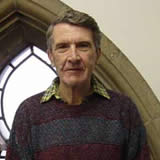

![]()
::: postdoc fellowships
::: senior fellowships
::: resident fellowships
::: associateships
![]()
being here
::: visiting
::: the last donut
::: photo album
::: center home >> people >> visiting fellows, 2003-04 >> chalmers |
||||
| Alan
Chalmers A fairly reliable way of assuring oneself of the reality of something is to use your senses; even when they seem to deceive you (as when your eyes seem to convince you of the convergence of railroad tracks in the distance or that a stick bends when it enters the water), you use your senses to check the appearances. But one of the most amazing things about the natural sciences is that some of their most powerful theories, those with the most explanatory power and the widest applications, are fundamentally about things that are beyond the reach of our senses. How have sciences such as physics and chemistry acquired and validated knowledge about atoms, the molecules they compose and the sub-atomic particles that compose them? This is clearly a question that needs to be explored by someone who is at once a historian and a philosopher of science—someone like this year’s Visiting Fellow Alan Chalmers. His background seems to have been designed so that he could work on his Center research project, ‘An Epistemological History of Atomism.’ Born and raised in Bristol, England, he began his academic career there as a physics student, earning his B.Sc. from the University of Bristol before taking an M.Sc. at Manchester. But his fascination with the historical and philosophical foundations of physics had already come to dominate by that time, and after two years of teaching math and physics he entered the History and Philosophy of Science program at the University of London to write a dissertation on the electromagnetic theory of the 19th century physicist James Clerk Maxwell. Upon graduating in 1971 he took a post-doctoral Fellowship at the University of Sydney in Australia and liked it so much he stayed, beginning as a Lecturer in Philosophy in 1973, eventually moving to the Science faculty in 1986 as Director of, and Professor in, Sydney’s Unit for History and Philosophy of Science, a position he held until his retirement in 1999. Upon retiring he became a Senior Research Fellow in the Philosophy Department at Flinders University, whence he came to visit us in Pittsburgh. His importance to the development of History and Philosophy of Science in Australia has not gone unnoticed. In 1998 Alan was elected a Fellow of the Australian Academy of the Humanities and awarded a Centenary Medal by the Australian Government, on behalf of the Queen, for ‘Services to the Humanities in the area of History and Philosophy of Science’ in 2003. The theme that fascinates him, and to which he returns regularly, is the precise ways in which evidence provides confirmation for physical theories. The atomic theory seems an ideal object for such a topic. As a philosophical approach to understanding the nature of the physical world, it was defended in the Classical world by Democritus and Epicurus in Greece and Lucretius in Rome; and during the Renaissance atomism, like so many other ideas with classical origins, had many defenders. But how does one turn an interesting metaphysical speculation about the nature of matter into a well-confirmed physical or chemical theory? Chalmers’ previous research on this topic led him to conclude that before the 19th century physicists and chemists sometimes paid lip service to atomism—or ‘the corpuscular philosophy’ as it was sometimes called—but their experimental work owed little to it and certainly provided no special confirmation for it. And even in the late 19th century some philosophically astute physicists found claims about the corpuscular nature of matter unsupported by the best experimental evidence. So how, and when, did that change take place? Chalmers research at the Center leads him to believe that, contrary to received opinion, nineteenth-century atomic chemistry was ill-confirmed and unproductive and that the considerable progress in chemistry made during that period in fact owed little to speculations about atoms. When we realize that a dime contains something of the order of a million, million, million, million molecules, it is perhaps not surprising to learn that nineteenth-century science lacked the theoretical and experimental resources to detect and learn about them. However interesting and important answering this question may be, what I have said so far might paint you a picture of a narrow specialist, unable or at least unwilling to address a wider audience. Not so; Alan is also the author of one of the most popular and widely read introductions to our field, What Is This Thing Called Science? translated into 19 languages including Estonian and Indonesian and now into its third edition. Now that’s globalization! Alan Chalmers doesn’t spend all his waking hours
locked in a study with historical texts. He admits to a passion
for ‘bush-walking’ (hiking as we call it in America),
one easily indulged whilst he taught in Sydney, since his home was
in the nearby Blue Mountains. For many years he also occasionally
could be found working on a cattle ranch in the Hunter Valley, owned
by one Sandra Grimes. Thanks to the fact that Sandra was able to
visit with Alan in Pittsburgh during part of his fellowship, we
at the Center are better able to understand why an ex-pat historian
and philosopher of science developed an interest in cattle ranching! |
|
|||
